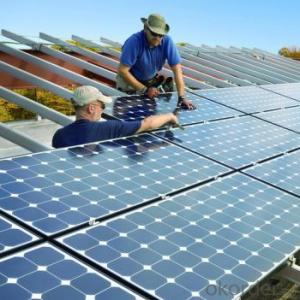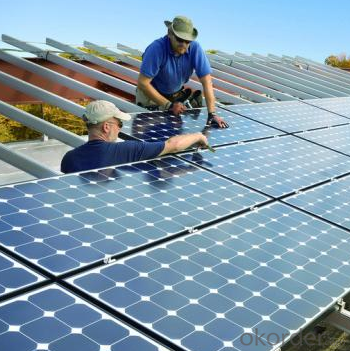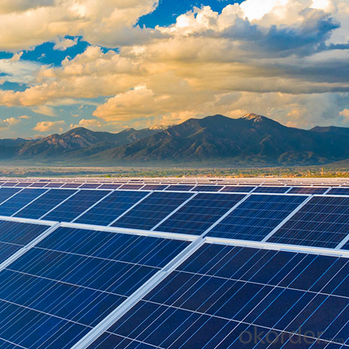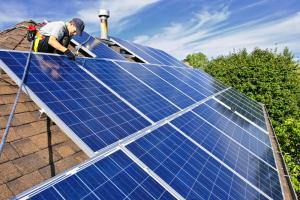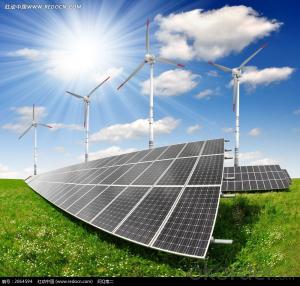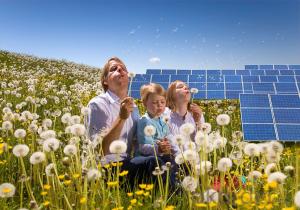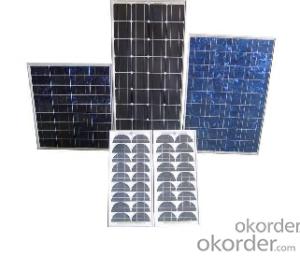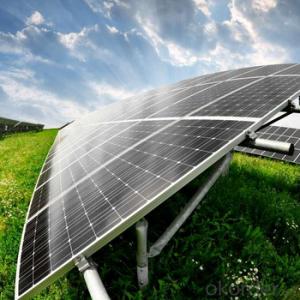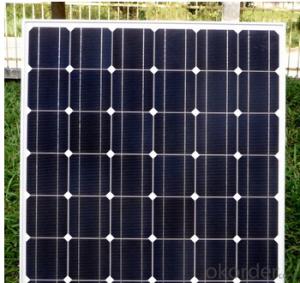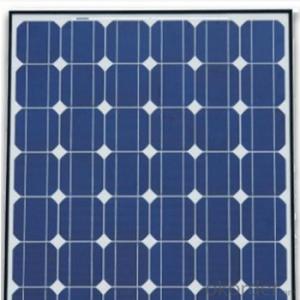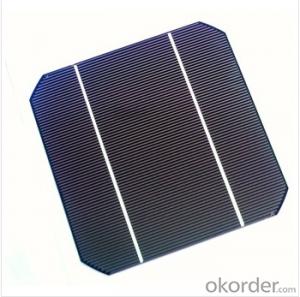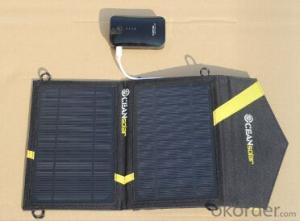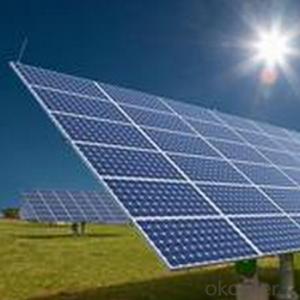Solar Panels Lancashire - Solar Charger for Outdoor Use Power Walk CS-C011
- Loading Port:
- China main port
- Payment Terms:
- TT OR LC
- Min Order Qty:
- 200 watt
- Supply Capability:
- 50000 watt/month
OKorder Service Pledge
OKorder Financial Service
You Might Also Like
Instruction
Format : 156 mm × 156 mm ± 0.5 mm
Thickness: 210 μm ±40 μm
Feature
1. High efficiency and High power.
2. Long-term electrical stability.
3. Lowest price and Fastest delivery.
4. Good quality and best service.
5. Bulk supply
Images
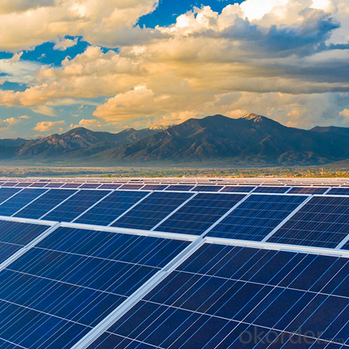
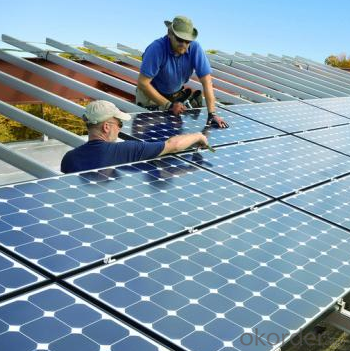
Specification
Electrical Characteristic of Mono Solar Cells
Efficiency (%) | Pmpp (W) | Umpp (V) | Impp (A) | Uoc (V) | Isc (A) | FF (%) |
18.35 | 4.384 | 0.526 | 8.333 | 0.63 | 8.877 | 78.39% |
18.20 | 4.349 | 0.526 | 8.263 | 0.63 | 8.789 | 78.54% |
18.05 | 4.313 | 0.525 | 8.216 | 0.63 | 8.741 | 78.32% |
17.90 | 4.277 | 0.524 | 8.161 | 0.629 | 8.713 | 78.04% |
17.75 | 4.241 | 0.523 | 8.116 | 0.629 | 8.678 | 77.70% |
17.60 | 4.206 | 0.521 | 8.073 | 0.628 | 8.657 | 77.36% |
17.45 | 4.170 | 0.519 | 8.039 | 0.628 | 8.633 | 76.92% |
17.30 | 4.134 | 0.517 | 8.004 | 0.626 | 8.622 | 76.59% |
17.15 | 4.098 | 0.516 | 7.938 | 0.625 | 8.537 | 76.80% |
17.00 | 4.062 | 0.512 | 7.933 | 0.625 | 8.531 | 76.18% |
16.75 | 4.002 | 0.511 | 7.828 | 0.625 | 8.499 | 75.34% |
16.50 | 3.943 | 0.510 | 7.731 | 0.625 | 8.484 | 74.36% |
FAQ
We have organized several common questions for our clients,may help you sincerely:
1. What’s price per watt?
A: It’s depends on the quantity, delivery date and payment terms of the order. We can talk further about the detail price issue. Our products is high quality with lower price level.
2. Can you tell me the parameter of your solar cells?
We have different series of cells with different power output, both from c-si to a-si. Please take our specification sheet for your reference.
3. How do you pack your products?
We have rich experience on how to pack the panels to make sure the safety on shipment when it arrives at the destination.
- Q: Can solar panels be used for powering a manufacturing facility?
- Yes, solar panels can be used to power a manufacturing facility. Solar panels convert sunlight into electricity, which can be utilized to run various equipment and processes within a manufacturing facility. By installing a sufficient number of solar panels, a manufacturing facility can significantly reduce its reliance on traditional grid electricity and lower its carbon footprint. However, the feasibility and effectiveness of solar panels for powering a manufacturing facility would depend on factors such as the facility's energy requirements, available sunlight, and the size of the solar panel system installed.
- Q: Can solar panels be damaged by birds or other animals?
- Yes, solar panels can be damaged by birds or other animals. Birds may create nests under solar panels, which can cause damage to the wiring or block sunlight. Additionally, animals like squirrels or rodents can chew on the wires, potentially causing electrical issues. It is recommended to take preventive measures, such as installing barriers, to protect solar panels from such damage.
- Q: Can solar panels be installed on walls?
- Yes, solar panels can be installed on walls. Wall-mounted solar panels are known as solar wall systems, and they are a viable option for generating electricity from the sun. These panels are typically installed vertically on the sides of buildings or other structures, allowing for efficient use of space.
- Q: how efficient are flexible solar panels?
- I don't have a number, but in general, no one uses a flexible panel unless they are compelled to. The efficiency is lower, and my experience is that they don't last. I had one a few years ago, and it lasted less than 2 years. My rigid panels came with a 25-year performance warranty, and are still working great after 7 years.
- Q: I contend:As far as the solar panels causing global warming I'll try to explain. If you put a black panel on the ground or on your house and don't connect it to anything, it will absorb solar energy (heat) during daylight and release it at night (radiation). The net heat gain is zero. If you hook up a solar panel in the same place but hook it up to batteries, charge the batteries during sunlight hours and using that energy to electrically heat the home at night. The panels will absorb solar energy during the day but will convert that to electrical energy in the batteries instead of radiating it back into space at night. The result is a net gain in earth's temperature.Right or wrong?
- Third Law of Thermodynamics (in normal speak): “Not only can you never get ahead, you can’t even break even.” This is a truism that applies to all activities involving energy exchange (and almost everything else as well). Energy in the form of solar radiation falls on the earth. That energy is absorbed by the planet (everything) and heat results. Some portion of that energy is lost in the absorption process and the net released as heat is less than that absorbed from the sun. This is true in all cases. Solar panels, both photovoltaic and heat collectors are subject to the Third Law and they all lose some of the radiant energy striking them in the process of converting that energy into either hot water (or whatever fluid) or electrical energy. Regardless of the process there is always a net loss of energy. The time delay you mention has no bearing on the total heat gain or loss for the planet. In fact the “solar panel effect” reduces the net energy put back into the ecosystem because it introduces another iteration of energy loss through conversion. The Holy Grail of energy conservation it the ability to use, store or recover the entire amount of energy produced regardless of the source of that energy, burning hydrocarbons, geothermal heat exchange, solar radiation, mice on treadmills …..all forms of energy suffer a net loss in any exchange! If we could avoid that loss we could dramatically reduce the heat lost into the atmosphere or ground water and our net energy gain would also be dramatic! Check out the super cooled circuits in use to reduce resistance in sophisticated electronic equipment for a good example of the energy savings. (Of course the savings do not account for energy lost in the cooling process. In any event NO….. solar panels do not contribute to global warming via their operation. (Their manufacture is another story altogether!)
- Q: Can solar panels be installed on parking lots or garages?
- Yes, solar panels can be installed on parking lots or garages. In fact, these locations are ideal for solar panel installations as they provide ample space for the panels and can harness the solar energy efficiently. Additionally, installing solar panels on parking lots or garages can also provide shade for vehicles and reduce energy costs for the facility.
- Q: Solar panels single crystal and double crystal in the rain which is easy to use
- From the cost of production, than the monocrystalline silicon solar cells to be cheaper, easy to manufacture materials, saving power consumption, the total cost of production is low, so get a lot of development. In addition, the polysilicon solar cell life than monocrystalline silicon solar cells shorter. From the performance and price ratio, monocrystalline silicon solar cells also slightly better.
- Q: can you buy single solar panels say to power a washing machine fridge etc.if so where can i buy them from
- Electicity okorder
- Q: how much do solar panels cost?
- The silicon ones(last 5 to 25 years) run about $4-$5 a watt the amorphous (thin film) a little less (may last 5-0 years). If you use megawatt hour (000 kilowatt hr) a month you will need at least 3000 watts minimum. Therefore if your electric is .0 per kilowatt hr( $00 per month) the payback is around 25 years once you add the batteries plus inverters(batteries $50-$00 each)(synchronous inverter $3000 to$20000)(ie $5.00/.0=50 months at optimum output).Figure (depending where you live) probably only 50% so break even is usualy about 20 yrs.Ie you pay 20 years electric bill and hope nothing breaks(insurance not included) then you can start saveing money.
- Q: Can solar panels be installed on bridges or highways?
- Yes, solar panels can be installed on bridges or highways. This is known as solar roadways or solar bridges. These panels can generate electricity by harnessing sunlight and can be integrated into the surface of bridges or highways. However, the feasibility and practicality of such installations may vary depending on factors like structural considerations, cost, maintenance, and local regulations.
Send your message to us
Solar Panels Lancashire - Solar Charger for Outdoor Use Power Walk CS-C011
- Loading Port:
- China main port
- Payment Terms:
- TT OR LC
- Min Order Qty:
- 200 watt
- Supply Capability:
- 50000 watt/month
OKorder Service Pledge
OKorder Financial Service
Similar products
Hot products
Hot Searches
Related keywords
